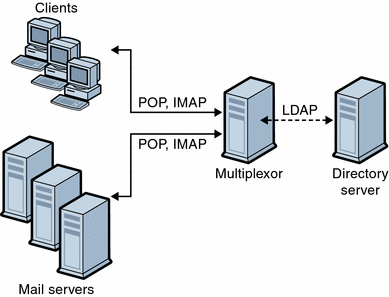How the Messaging Multiplexor Works
The MMP is a multithreaded server that facilitates distributing mail users across multiple server machines. The MMP handles incoming client connections destined for other server machines (the machines on which user mailboxes reside). Clients connect to the MMP itself, which determines the correct server for the users, connects to that server, and then passes data between the client and server. This capability allows Internet service providers and other large installations to spread message stores across multiple machines (to increase capacity) while providing the appearance of a single mail host for users (to increase efficiency) and for external clients (to increase security). How the Messaging Multiplexor Works shows how servers and clients relate to each other in an MMP installation.
Figure 7–1 Clients and Servers in an MMP Installation

All POP, IMAP, and SMTP clients work with the Messaging Multiplexor. The MMP accepts connections, performs LDAP directory lookups, and routes the connections appropriately. As is typical with other mail server installations, each user is assigned a specific address and mailbox on a specific Messaging Server. However, all connections are routed through the MMP.
In more detail, these are the steps involved in establishing a user connection:
-
A user’s client connects to the MMP, which accepts preliminary authentication information (user name).
-
The MMP queries the Directory Server to determine which Messaging Server contains that user’s mailbox.
-
The MMP connects to the proper Messaging Server, replays authentication, then acts as a pass-through pipe for the duration of the connection.
- © 2010, Oracle Corporation and/or its affiliates
